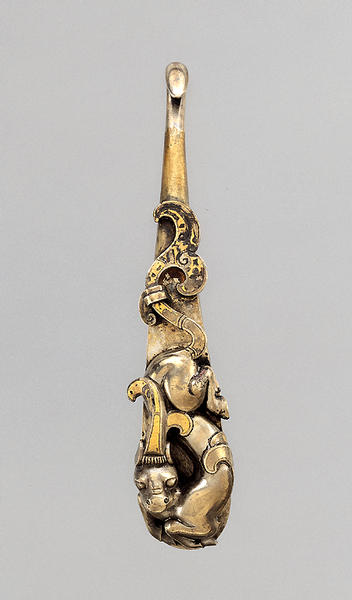留金
- 中国
- 中国・前漢時代
- 前206-後9年
- 銀、金
- H-9.4
この作品の動物は恐らく「吉兆」を意味する祥瑞という観念を表していると考えられる。この観念は前漢時代の美術及び文学に顕著に描写されている。祥瑞は伝説上の獣の形をとって現れる前兆である。こうした獣の出現は不死が約束された徴と考えられ縁起が良いものとされた。この瑞獣は弧を描く翼、蹄、先端が巻き込んだ二股に分かれる長い尾をもち、銀鍍金の衣の留鉤に高浮き彫りで表されている。その胴部は中空で、留金の形に一致するよう巧みに体が曲げられている。動物と留金は別々に鋳造され、鋳足しないし溶接で接合されている。背面からは衣服に取り付けるための、短い軸をもつ大きなボタンが突出している。その小ささと意匠が垂直方向に伸びていることから、恐らく帯を締めるためのものではなく、胸ないし肩などのどこかに垂直方向に装着されたであろうと思われる。
Catalogue Entry
The fantastic animal on this hook probably represents the concept called "good omens," xiangrui, that figured prominently in the art and literature of the western Han period.1 Xiangrui were portents in the shape of mythical beasts that were considered good luck because their appearance signaled the approval of heaven. This xiangrui with curved wing, hooves, and long bifurcated tail with curling ends is shown in high relief on a gilt-silver garment hook. Its body is hollow and ingeniously articulated to conform to the general shape of the hook. The animal and the hook were cast separately and then joined together by casting-on or soldering. The hook itself is a later replacement or repair for the now-missing original hook. A large button on a short stem projects from the back for attachment purposes. Its small size and vertical orientation indicate that this garment hook was probably not intended to fasten a belt but may have been worn vertically somewhere on the chest or the shoulders.
Silver was not easily obtainable in ancient China and never gained the prominence in Chinese culture achieved by jade, bronze, and gold.2 In central China, silver appears to have been almost unknown before the fifth century B.C., when bronze-casters began to use it decoratively to embellish luxury items made of other materials, such as belt hooks like catalogue number 91.
Gold inlay marks the crest, wing, and tail of the silver beast on this garment hook. This was achieved by inlaying these areas with gold foil, and then driving the edges of the foil into previously outlined grooves in the silver, conceivably with a chisel that cut the gold.
A fragmentary garment hook excavated from a Western Han tomb in Luobowan, Gui Xian, Guangxi province, appears to be a bronze version of the present hook.3 Most of its fantastic animal is now missing, but the remaining bifurcated tail and the body of the hook are almost identical in shape (fig. 1). The Luobowan example terminates in a broad, flat, snake-like head, exactly the type that may once have adorned the Shumei garment hook before the original was lost.
ECB
1. For discussions of xiangrui see Wu 1984; Wu 1986; Wu 1989.
2. Bunker 1994, pp. 73-74.
3. Guangxi Gui Xian Luobowan Han mu 1988, fig. 43.7. I am most grateful to Dr. Jenny F. So for bringing this reference to my attention.
